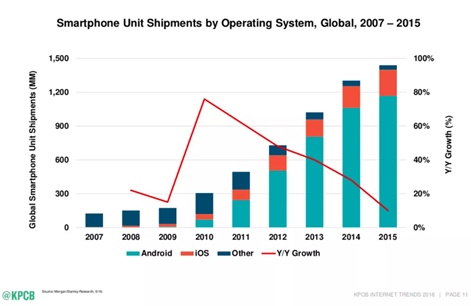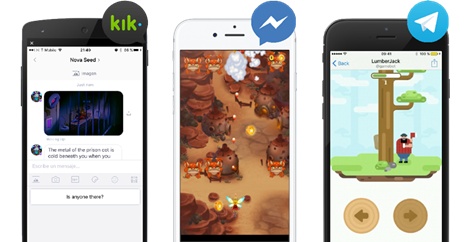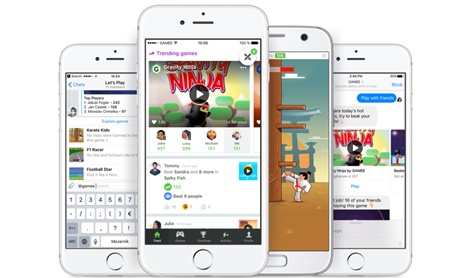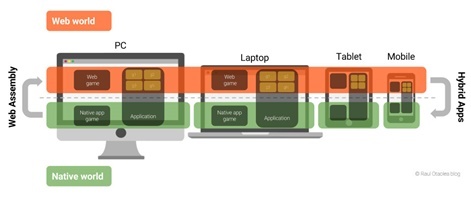Raul Otaolea is Co-Founder and CEO of web platform WiMi5.
This article was originally published on LinkedIn.
In a previous article, I went over the most relevant advances in the area of web technologies of the last decade.
The objective was to measure the level of maturity of these technologies, to look at them from the perspective of trying to predict how the web will evolve as a gaming platform in the next few years.
On this occasion, I’m going to talk about my view of the future. Obviously, this is a bit daring on my part, and time will prove me right or wrong. However, it seems like a constructive activity to me, so with crystal ball in hand, here I go.
I’ve divided this article into four sections, which represent the most important possibilities for revolutionising the web game industry, as well as the implications of this for other platforms.
New web platform
With the opening of mobile stores, first the App Store and then Google Play, a new industry was created, based on the mobile platform, which we all know has grown exponentially.
Since then, web games have suffered a considerable decline that parallels the growth of the mobile platform.
With a similar offer in terms of type of games, mobiles, with their massive deployment and constant use, can offer a new user experience that is incredibly accessible. The result has been a substantial migration of players from the web to mobile devices.

The web, as a platform, couldn’t compete with mobiles, since web standards were still very immature and aimed mainly at desktop browsers.
The biggest obstacle in that time period was that mobile browsers didn’t have the same abilities that desktop browsers did, meaning it wasn’t possible to develop web games. Web games for the mobile simply didn’t exist.
Now, however, we’re living in an unprecedented time in the history of the web, which looks like it might change the balance.
After 15 years of little to no evolution, practically all standard technologies that make up the web have been updated in the last two years.
After 15 years of little to no evolution, practically all standard technologies that make up the web have been updated in the last two years. In my opinion, this technological transition is having a radical impact, which I summarise below:
- The new standards allow for the creation of content that was impossible with the older versions, rivaling in capacity and performance what mobiles offer natively (2D, 3D, peripherals, professional sound, access to hardware, etc.).
- The standards are applied to all browsers, including mobile versions. This means that, for the first time in history, it’s possible to develop video games that work on all devices, opening access to more than two billion mobiles and tablets.
- With the new standards, non-standard technologies, especially Flash, which were in massive use up to now in video game development, are no longer necessary. Web browser developers have decided to block non-standard content. This is forcing thousands of websites still running Flash games to update their entire portfolio.
- The web transcends browsers. Thanks to the open nature of the implementation of standards, it’s possible to develop solutions based on open-source code projects (Chromium, V8, Chakra, JavaScriptCore, SpiderMonkey, NodeJS, etc.), which allows apps that exploit the advantages of these web standards to be created.
Therefore, the word “new” that I used in the title of this section is of vital importance. We are now in a position to re-imagine web games, hoisting them up into a new category, leaving behind the belief that they can only be second or third-rate products.
From now on, web games will be first-class citizens that offer top-quality content. It’s only a matter of time before we see 2D and 3D games, in single-player and multiplayer, with high quality sound and graphics, working smoothly on all devices.
In fact, the main web game sites are already noticing this change, as can be seen in a recent tweet from Emily Greer, the CEO of Kongregate.
After years of being the future of browser games, HTML5 is finally the present. pic.twitter.com/EPwnxytwBj
— Emily Greer (@EmilyG) March 7, 2017
Another relevant aspect is that the process of updating the web has radically changed. From now on, updates to web standards will be much more frequent, and will parallel the advancement of technology.
No longer will we have to wait 15 years to see new features. In fact, the next versions are already popping up: HTML5.1, ES7, ES8. This ensures a much more agile evolution of the web, and therefore more possibilities to create better and different types of games.
This change is also arriving in a moment of severe overcrowding on mobile app stores, where large investments in marketing and publicity are needed in order to have any kind of visibility and reach users.
My opinion is that the recent evolution of web standards isn’t just a mere update, but rather a disruptive change, since it offers new capabilities that are in a completely different order of magnitude.
The recent evolution of web standards isn’t just a mere update, but rather a disruptive change.
You have to keep in mind that they’re cramming 15 years of software progress in at once. That’s why my view, now more than ever, is that the web is turning into the next gaming platform, and that it will, as such, open up a new industry that’s still to be explored.
The main challenge for the web to experience exponential growth and exploit its multi-platform capability is for mobile users to willingly accept playing on a browser.
This is an important bottleneck, because up to now, the only way to play a video game was to go to the store, find it and download it. In fact, this process represented the life cycle of the app, and the native way of working in the mobile platform. This model has created a habit in users that will be hard to modify.
However, new APIs like Google’s Add to Homescreen are channeled right at proposing an alternative. This API allows a web page to ask the user if they’d like to create a shortcut on the mobile desktop.
If the user agrees to do so, an icon, indistinguishable from that of a classic app’s icon, will be created, and when tapped, the icon will open the browser in full screen, even hiding the browser’s address bar, again making it indistinguishable from an app.
So, the user’s experience will be very similar to that when using a native app. We’ll have to wait and see if other browsers implement this feature.
Super-apps as platforms
The most important feature of web standards is their multi-platform nature. The most obvious way of consuming multi-platform video games is the browser. However, it’s not the only one.
Super-apps are creating a new trend that intelligently exploits the multi-platform nature of the web. Super-apps are normal apps that have evolved into becoming their own platforms. This means that they offer the possibility of installing other services, designed by third-parties, in the app itself.
The first services offered in this new mode were bots and video games. The challenge was to select a sufficiently powerful, flexible, and popular technology that would work on all operating systems, and obviously, the best-adapted technology to working on a large number devices is the web.

The first super-apps to offer HTML5 games developed by third-parties and embedded in their platform were messaging apps Telegram, Kik and Messenger.
The most interesting thing about these messaging apps is that they’re actually social networks that use video games as a tool for increasing user engagement.
You have to keep in mind that between these three super-apps, there are more than two billion monthly users. This allows developers to get the chance to have their games go viral, exploiting the social characteristics of these apps like challenging friends, sharing achievements, creating rankings, etc.
On the other hand, messaging app users find an instant entertainment option without having to leave the app, which is a new user experience. A priori, this is a win-win situation, because the app, the developer community, and finally users all benefit.
Super-apps are creating a new trend that intelligently exploits the multi-platform nature of the web.
We’ll have to keep a close eye on the evolution of these and other super-apps to see if they can consolidate as yet another gaming platform.
Apps as game portals
Another interesting trend that is exploiting the same feature as super-apps, but with a different focus, is that of apps that act as game portals.
These are apps that can mix native features with games developed in HTML5. Like super-apps, web technologies allow them to update their game portfolio dynamically and instantaneously, that is, without having to go through all the approval steps in stores.
Another advantage is that since we’re dealing with web content, they can also offer the same games via conventional websites, publish them in super-apps, or even turn themselves into super-apps by offering their app to third-parties for publishing.
This way, they can make the most of all channels. An excellent example of this type of app is Gamee, which just raised another round of financing totaling $2.2 million.

Also in this category, but with different focuses, are two other interesting startups: Blackstorm and PlatoApp.
Blackstorm raised $33 million in their first round of financing, which they’re going to use to try to become the alternative to app stores. The company has also been one of those chosen to create one of the first HTML5 games for Messenger, called EverWing.
And just a week ago, we heard about the opening of a company called RGames along with Japanese giant Rakuten. The goal is to launch an HTML5 video games portal for the Japanese and Asian markets.
Similarly, PlatoApp is proposing a combination between a messaging app and classic multiplayer games. Although their first round of financing raised a more modest $3 million, Plato is led by the creators of Yahoo! Games, which will certainly lead to interesting proposals.
Unlike other platforms, the web doesn’t have a destined device / operating system combo, but rather an implementation of the standard.
My opinion is that we’ll soon see more startups based on this approach, as they can make the most of all the options that web technologies currently offer when it comes to video games.
Hybridisation of platforms
Video game platforms are made up of three pillars: a device with an operating system that runs the game, a tool to develop it with, and a marketplace to distribute it.
In the web platform, thanks to its open nature, there isn’t a single entity that offers these three elements, but rather delegates these roles to the industry.
This way, the web doesn’t have one development tool, but rather many. There isn’t just one marketplace, but many. And they’re not limited to one type of device and one operating system, but rather they can work on all of them.
Plus, unlike other platforms whose main axis is a device and/or operating system like Xbox, PlayStation, Switch, Android and iOS on mobiles, the web doesn’t have a destined device/operating system combo, but rather an implementation of the standard.
That is to say, it’s a software platform, most commonly a web browser. However, as I commented earlier, this is changing quickly, and the browser is just one of the many examples of the implementation of this standard.

This technology, expressly designed to adapt to many devices and operating systems with different characteristics, is also building bridges to other platforms.
With this, not only is the platform more flexible, but it’s also evolving to a platform where the whole world can be. In fact, my opinion is that it’s a platform where everyone will want to be. And they’ll do so by using three technologies:
This allows video games developed in C++ and other languages to be ported to JavaScript. Actually, it translates it to a subset of JavaScript called asm. There are many examples out there of the use of this technology.
This is still in development, but it represents a milestone in the production of web games. We could say that WebAssembly is the optimised and official evolution of Emscripten.
Not only is the platform more flexible, but it’s also evolving to a platform where the whole world can be.
It also lets games developed in other programming languages to be ported to WebAssembly, and develop general purpose highly optimised modules. Browsers will be able to run WebAssembly safely and with a performance that is near native.
All the professional game tools, such as Unity, Unreal, etc., are already working to be able to export their games to WebAssembly. That is why this will mean the launch of a new category of web games, which will coexist with their native brethren on other platforms.
It’s going to be very interesting to see how the same game will evolve on different platforms, with different marketing campaigns designed ad hoc for each platform. Since web marketing is so much more affordable that native platforms, my opinion is that the presence of web games will grow well in the next few years.
- Hybrid apps
These are apps that actually include a pseudo-browser that runs the game. The appearance and the user’s experience is the same as a conventional app, making them indistinguishable from conventional apps most of the time. Many companies are taking this approach, not just for games, but also for all types of apps, because it allows them to port them easily to other platforms.
Soon, the concept of web will transcend the desktop browser and open up to include all browsers, including those on mobiles, televisions and other devices.
Bearing all this in mind, and that the web already represents a multi-device platform, it’s clear that soon, the concept of web will transcend the desktop browser and open up to include all browsers, including those on mobiles, televisions and other devices.
The fact that games on other platforms can be ported to the web with one click will make the rivalries and the lack of confidence of the web as a gaming platform diminish.
The time will come when the web is a normal target platform; the process will go from developing a mobile game and porting it to the web, to design a game taking into account from scratch that it will be ported to the mobile and the web, for example.
Conclusion
Keeping all the above in mind, it’s clear that in the next few years, we’re going to see video games developed with web technologies designed for browser for all devices; video games embedded in apps; video games aimed at messaging apps; and video games developed in other languages and ported to the web all living together. And they’ll all be web games.
There will be a lot of changes in a short amount of time, and this will have an interesting affect on the video game industry as a whole.
What’s clear is that the web is the next gaming platform, a new and special platform, different to the existing ones, but which leverages their potential and at the same time complements them.
Isn’t it wonderful?





















